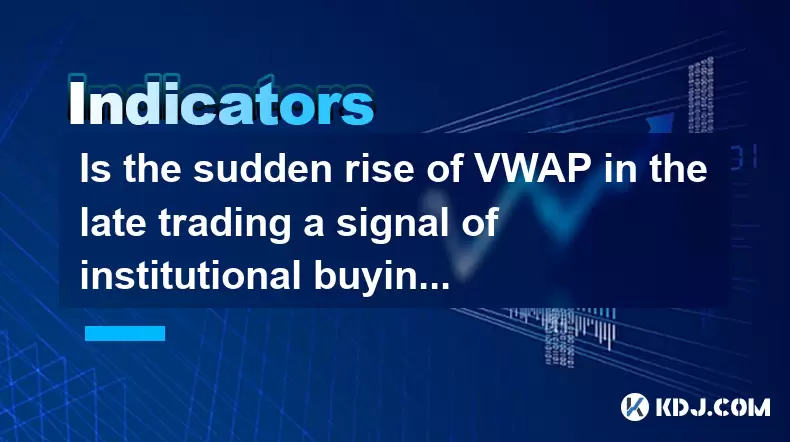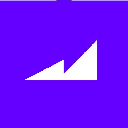-
 bitcoin
bitcoin $109547.008142 USD
0.04% -
 ethereum
ethereum $4011.838726 USD
-0.05% -
 tether
tether $1.000402 USD
-0.01% -
 xrp
xrp $2.798606 USD
0.88% -
 bnb
bnb $970.877944 USD
1.39% -
 solana
solana $202.237275 USD
-0.95% -
 usd-coin
usd-coin $0.999673 USD
0.00% -
 dogecoin
dogecoin $0.229294 USD
-1.15% -
 tron
tron $0.336370 USD
-0.45% -
 cardano
cardano $0.777260 USD
-1.66% -
 hyperliquid
hyperliquid $45.503019 USD
1.73% -
 ethena-usde
ethena-usde $1.000362 USD
0.01% -
 chainlink
chainlink $20.785303 USD
-1.10% -
 avalanche
avalanche $28.755822 USD
-0.11% -
 stellar
stellar $0.358303 USD
-0.48%
Is the sudden rise of VWAP in the late trading a signal of institutional buying?
A sudden VWAP rise in late crypto trading may signal institutional buying, but traders should consider volume, order book, and market context for confirmation.
May 22, 2025 at 01:21 am

The sudden rise of the Volume Weighted Average Price (VWAP) in the late trading sessions of a cryptocurrency can indeed be an intriguing signal. Many traders and analysts look at VWAP as a key indicator to understand the buying and selling pressure in the market. When VWAP experiences a sudden rise in the late trading hours, it often prompts speculation about the involvement of institutional investors. In this article, we will explore the concept of VWAP, the significance of its late trading surge, and whether it can be reliably considered as a signal of institutional buying.
Understanding VWAP
Volume Weighted Average Price (VWAP) is a trading benchmark used by investors to determine the average price a security has traded at throughout the day, based on both volume and price. It is calculated by taking the total dollar amount of all trades and dividing it by the total trading volume. The formula for VWAP is as follows:
[ \text{VWAP} = \frac{\sum (\text{Price} \times \text{Volume})}{\sum \text{Volume}} ]
VWAP is particularly useful for traders because it provides a fair value indicator for the day. When the price of a cryptocurrency is above the VWAP, it is considered overvalued, and when it is below, it is considered undervalued. This can help traders make informed decisions about when to buy or sell.
The Significance of Late Trading Sessions
Late trading sessions, typically occurring in the evening or night hours, can be significant for several reasons. These sessions often see lower liquidity compared to the day sessions, which can lead to more volatility. Additionally, late trading can be influenced by different market participants, including retail traders and institutional investors who might be adjusting their positions before the next trading day.
The behavior of the market during these hours can provide clues about the intentions of large investors. If the VWAP rises suddenly during late trading, it might suggest that significant buying activity is taking place, potentially driven by institutions looking to accumulate positions without causing too much price movement during the more liquid day sessions.
Institutional Buying and VWAP
Institutional investors, such as hedge funds, pension funds, and large trading firms, often have significant capital at their disposal. Their buying activity can have a substantial impact on the market, especially in the less liquid late trading sessions. When these investors decide to buy, they often use strategies to minimize their market impact, such as spreading their orders over time or using algorithms to execute trades.
A sudden rise in VWAP during late trading could be indicative of institutional buying for several reasons. First, institutions might use the lower liquidity to their advantage, allowing them to buy larger volumes without causing a significant spike in the price. Second, they might be using VWAP as a benchmark to ensure they are getting a favorable average price for their trades.
Analyzing the Sudden Rise in VWAP
To determine whether a sudden rise in VWAP during late trading is indeed a signal of institutional buying, traders need to look at several factors. Volume is a critical component. A significant increase in trading volume accompanying the VWAP rise can be a strong indicator of institutional involvement. Additionally, traders should examine the order book and trade data to see if there are large buy orders being executed.
Another factor to consider is the price action around the VWAP. If the price consistently stays above the VWAP after its sudden rise, it could suggest strong buying pressure, potentially from institutional investors. Conversely, if the price quickly reverts below the VWAP, it might indicate that the buying was not sustained enough to be considered institutional.
Other Factors to Consider
While a sudden rise in VWAP during late trading can be a signal of institutional buying, it is important not to rely solely on this indicator. Other market factors can also influence VWAP and price movements. For example, news events, market sentiment, and technical analysis indicators can all play a role in the sudden rise of VWAP.
Traders should also consider the overall market context. If the broader market is experiencing a bullish trend, a sudden rise in VWAP might be part of a larger market movement rather than isolated institutional activity. Conversely, if the market is bearish, a rise in VWAP could be more significant as it goes against the prevailing trend.
Practical Steps to Analyze VWAP Rise
To effectively analyze a sudden rise in VWAP during late trading, traders can follow these practical steps:
- Monitor Trading Volume: Look for a significant increase in volume that coincides with the VWAP rise. High volume can be a strong indicator of institutional involvement.
- Check the Order Book: Examine the order book for large buy orders. Institutional investors often place large orders that can be spotted in the order book.
- Analyze Price Action: Observe the price movement around the VWAP. If the price stays above the VWAP after its rise, it suggests strong buying pressure.
- Consider Market Context: Take into account the broader market trend and any relevant news events that might be influencing the market.
- Use Technical Indicators: Combine VWAP with other technical indicators, such as moving averages or RSI, to get a more comprehensive view of the market.
Conclusion
In conclusion, a sudden rise in VWAP during late trading can be a potential signal of institutional buying. However, traders should approach this signal with caution and consider multiple factors, including trading volume, order book data, price action, and the overall market context. By combining these elements, traders can make more informed decisions about whether the rise in VWAP is indeed indicative of institutional activity.
Frequently Asked Questions
Q1: Can VWAP be used as a trading strategy on its own?A1: While VWAP can be a valuable tool for traders, it is generally more effective when used in conjunction with other indicators and strategies. Relying solely on VWAP might lead to missed opportunities or false signals, especially in volatile markets.
Q2: How can retail traders benefit from understanding institutional buying patterns?A2: Retail traders can benefit by aligning their trades with the potential moves of institutional investors. By recognizing patterns of institutional buying, retail traders can position themselves to take advantage of the resulting price movements.
Q3: What other indicators should traders use alongside VWAP to confirm institutional buying?A3: Traders can use indicators such as the Moving Average Convergence Divergence (MACD), Relative Strength Index (RSI), and Bollinger Bands to confirm institutional buying. These indicators can provide additional insights into market trends and momentum.
Q4: How does the time of day affect the reliability of VWAP as an indicator of institutional buying?A4: The time of day can significantly affect the reliability of VWAP. Late trading sessions often have lower liquidity, which can make VWAP movements more pronounced and potentially more indicative of institutional activity. However, traders should always consider the overall market context and other factors before drawing conclusions.
Disclaimer:info@kdj.com
The information provided is not trading advice. kdj.com does not assume any responsibility for any investments made based on the information provided in this article. Cryptocurrencies are highly volatile and it is highly recommended that you invest with caution after thorough research!
If you believe that the content used on this website infringes your copyright, please contact us immediately (info@kdj.com) and we will delete it promptly.
- Altcoin Season Heats Up: Is ARB, PEPE, or a New Challenger Your Best Bet?
- 2025-09-28 10:25:11
- Shiba Inu, Meme Coins, and Popularity: What's Hot and What's Not in the Wild World of Crypto
- 2025-09-28 10:25:11
- Cardano, Toncoin, and the Quest for Crypto's Next Big Thing
- 2025-09-28 10:45:12
- XRP, Ripple, and the Payment Token Race: What's Next?
- 2025-09-28 10:45:12
- MoonBull Mania: Is This the Next Bonk in the Cryptoverse?
- 2025-09-28 10:30:00
- Bitcoin's 'Uptober' Hopes Clash with Selling Pressure: A New Yorker's Take
- 2025-09-28 10:50:01
Related knowledge

What is a tower bottom candlestick pattern? Does it have a high success rate?
Sep 22,2025 at 07:18am
Tower Bottom Candlestick Pattern Explained1. The tower bottom candlestick pattern is a reversal formation that typically appears at the end of a downt...

What is a black hole pattern in the MACD indicator? Is it a cause for concern?
Sep 21,2025 at 06:54pm
Bitcoin's Role in Decentralized Finance1. Bitcoin remains the cornerstone of decentralized finance, serving as a benchmark for value and security acro...

How can I use the psychological line (PSY) to determine market sentiment?
Sep 17,2025 at 02:19pm
Understanding the Psychological Line (PSY) in Cryptocurrency TradingThe Psychological Line, commonly referred to as PSY, is a momentum oscillator used...

How can I determine if a double top pattern has officially formed?
Sep 21,2025 at 03:18am
Understanding the Structure of a Double Top Pattern1. A double top pattern consists of two distinct peaks that reach approximately the same price leve...

What is the Golden Valley pattern on the moving average? Is it better than the Silver Valley pattern?
Sep 21,2025 at 02:54pm
Understanding the Golden Valley Pattern in Moving Averages1. The Golden Valley pattern is a technical formation observed in cryptocurrency price chart...

What does a death cross of the RSI in the strong zone (above 50) mean?
Sep 17,2025 at 10:54pm
Understanding the Death Cross in RSI Context1. The term 'death cross' is traditionally associated with moving averages, where a short-term average cro...

What is a tower bottom candlestick pattern? Does it have a high success rate?
Sep 22,2025 at 07:18am
Tower Bottom Candlestick Pattern Explained1. The tower bottom candlestick pattern is a reversal formation that typically appears at the end of a downt...

What is a black hole pattern in the MACD indicator? Is it a cause for concern?
Sep 21,2025 at 06:54pm
Bitcoin's Role in Decentralized Finance1. Bitcoin remains the cornerstone of decentralized finance, serving as a benchmark for value and security acro...

How can I use the psychological line (PSY) to determine market sentiment?
Sep 17,2025 at 02:19pm
Understanding the Psychological Line (PSY) in Cryptocurrency TradingThe Psychological Line, commonly referred to as PSY, is a momentum oscillator used...

How can I determine if a double top pattern has officially formed?
Sep 21,2025 at 03:18am
Understanding the Structure of a Double Top Pattern1. A double top pattern consists of two distinct peaks that reach approximately the same price leve...

What is the Golden Valley pattern on the moving average? Is it better than the Silver Valley pattern?
Sep 21,2025 at 02:54pm
Understanding the Golden Valley Pattern in Moving Averages1. The Golden Valley pattern is a technical formation observed in cryptocurrency price chart...

What does a death cross of the RSI in the strong zone (above 50) mean?
Sep 17,2025 at 10:54pm
Understanding the Death Cross in RSI Context1. The term 'death cross' is traditionally associated with moving averages, where a short-term average cro...
See all articles










































































